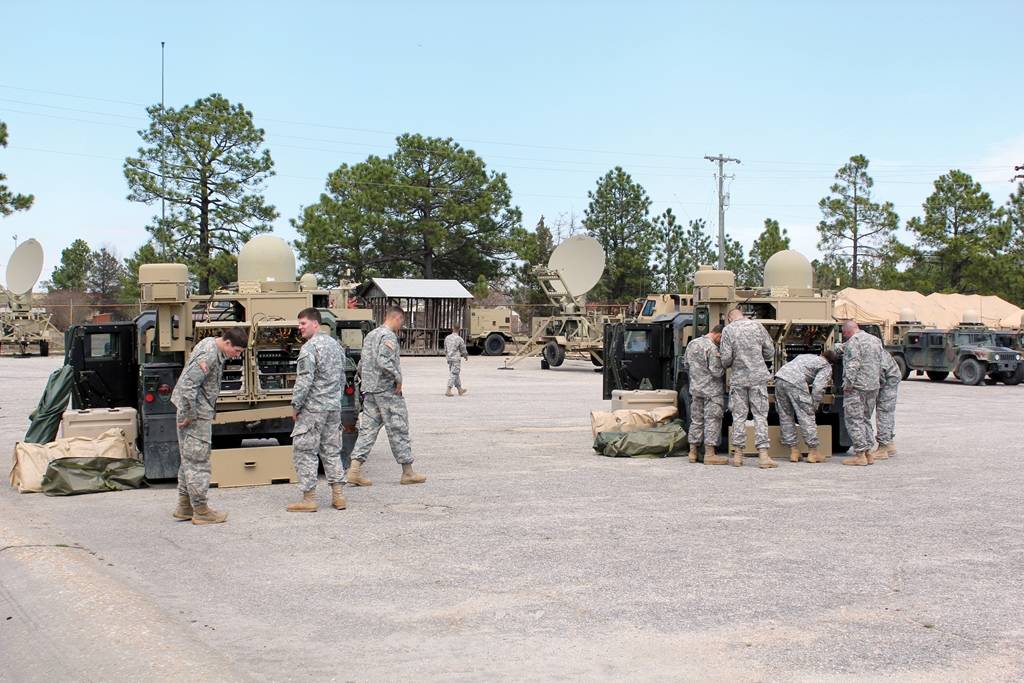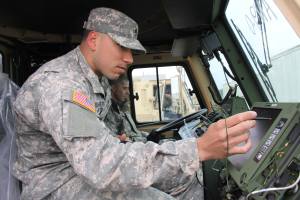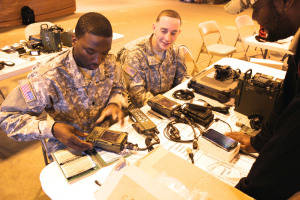
Tactical network training becomes more holistic and more versatile with every capability set fielding
When fielding complex new equipment to a unit, there’s only one chance to get it right. If the training is off—in content, timing or audience—the unit can end up worse than it was without the new gear. To get the most out of the Army’s advanced communications network, Soldiers need to understand how to fully employ their systems to satisfy their mission requirements, and how to maximize system capability as part of a holistic network that spans the entire force. As the Army fields its network capability sets, it is leveraging Soldier feedback and lessons learned from previous fieldings, deployments and Network Integration Evaluations to improve equipment and training. The service has learned the importance of taking a holistic, collective approach to network training while infusing that training with operationally relevant scenarios that hone in on the requirements of specific military occupational specialties (MOSs). This approach is expected to improve Soldiers’ performance and expand network capability while reducing burdens on the Soldier and the unit.
The Army has fielded Capability Set (CS) 13 to two division headquarters and four infantry brigade combat teams (BCTs), with three of the BCTs and both division headquarters deploying to Afghanistan with the system.
This integrated package of radios, satellite systems, software applications, smartphone-like devices and other network components provides connectivity across the entire BCT formation, from the static main command post to the commander on-the-move to the dismounted Soldier. Throughout 2014, the Army will field CS 14 components to seven BCTs and two division headquarters, building on CS 13 with hardware and software enhancements and adding the dual-channel Handheld, Manpack, Small Form Fit radio. User feedback identified the need to simplify the network to make it easier to use; provide quicker and more dynamic task reorganization; incorporate more time to train and prepare; and better synchronize capability set fielding and training with other unit tasks.
SUCCESS FACTORS
After the intensive developmental process for each system and the effort to integrate the systems into a capability set, the next phase—new equipment training (NET) and new equipment fielding (NEF)—might seem initially like the easiest part of the life cycle. However, executing capability set NET/NEF introduces new challenges to ensure that these new technologies can fulfill their role for a BCT.
A capability set takes months to train. Early in the process, it is vital to ensure that the unit understands the training as a team effort that includes the Soldiers, program executive offices, individual program manager (PM) offices, the System of Systems Engineering and Integration Directorate (SoSE&I) and other stakeholders. It is also important to set expectations for all parties as to the necessary manpower, facilities, time and effort.
The success of fielding and training events is tied directly to engagement of the unit leadership. The energy and emphasis applied to any mission derive from the value the unit leadership places on a mission. SoSE&I and PM representatives need to engage with the fielded unit’s key leaders early in the process so they understand the operational value of the network, the commitment necessary to internalize the new systems to BCT operations and the support that the acquisition community can provide. Timing is possibly the greatest factor in setting the conditions for success. Leadership emphasis is closely tied to the unit’s current Army Force Generation cycle. Failure to time fieldings effectively means the unit could have simultaneous and conflicting missions, in which case the unit’s leadership will likely emphasize the upcoming mission over capability set training. The likelihood of a successful fielding increases, as does the ability to employ the new capability effectively, if unit fielding is synchronized with the U.S. Army Forces Command during a period that minimizes distractions from external missions.
SYSTEM-OF-SYSTEMS TRAINING
In the first few capability set fieldings, PM offices were responsible for fielding their equipment, which ultimately provided more stovepiped individual NETs. Units ended up with systems on which they were well-trained, but some Soldiers weren’t familiar with how their systems interoperated across the brigade. The Program Executive Office for Command, Control and Communications – Tactical (PEO C3T), which supplies most of the systems that make up capability sets, has now opted for a more collective approach to training that underscores how each element of a capability set operates in a unified network. Taking place after individual system NET, this crawl-walk-run, system-of-systems training package is synchronized with the unit’s mission essential tasks.
Other important changes have come from the units themselves. The 3rd BCT, 101st Airborne Division (Air Assault) (3-101 ABN) was the fourth unit to receive CS 13 and did not face the compressed deployment timeline that challenged the first three units. The 3-101 took the opportunity to develop several process improvements since starting capability set fielding in late 2013. Working with PEO C3T and SoSE&I, the unit implemented a sustainment training program to ensure that Soldiers do not lose the skills developed in NET/NEF, created quarterly update briefs to account for leaders and signal personnel rotating in and out of the unit, and identified Soldiers throughout the brigade to serve as CS 13 subject-matter experts and troubleshooters, thus reducing dependence on civilian field support. This approach, which 3-101 has shared with counterparts in 1-101 receiving CS 14, also helps ensure that thorough training is provided not just to signal Soldiers but also to operators and leaders, so a BCT can “fight” the network to its maximum potential.
TO THE SCHOOLHOUSE
As part of the Army’s push to continually improve the network and training, it established Warfighter Information Network – Tactical Increment 2 (WIN-T Inc 2) institutional training at the U.S. Army Signal Center of Excellence, Fort Gordon, GA, in October 2013, with the first Soldiers (25N MOS, nodal network systems operator-maintainers) completing the courses in April. As part of capability set fielding, WIN-T Inc 2 is installed on tactical vehicles to add on-the-move access to the tactical network and extend the network over vast distances and difficult terrain. Institutional training will provide a pipeline of Soldiers who can operate the equipment proficiently when they arrive at their unit, enhancing mission accomplishment. The Army is also working to provide WIN-T Inc 2 schoolhouse training over the next few years for Soldiers in ordnance and other MOSs, including NCOs and warrant officers, who will provide maintenance support. As the Army improves institutional training and increases the number of trained Soldiers from Fort Gordon, it will be able to reduce its reliance on contracted field service representatives and achieve the objective of completely sustaining equipment with signal Soldiers.
Training in many of the capability set systems uses classroom and hands-on packages that contain an increasing amount of simulation. PM WIN-T is working to develop simulation packages for all of the WIN-T Inc 2 configuration items so that Soldiers can refresh their knowledge when needed. LandWarNet eUniversity, the Army’s online presence for sustainment and training in command, control, communications and computers, contains information on how Soldiers can deploy, operate and maintain some of the capability set systems.
Soldiers can access WIN-T Inc 2 training material, review modules or obtain operating procedures on the LandWarNet portal (https://lwn.army.mil) using their Common Access Card (CAC).
WIN-T NET SNAPSHOT
WIN-T Inc 2, the backbone of the Army’s capability sets, is the most capable and diverse of the network systems. Its NET is critical to the success of the entire capability set package. Depending on the MOS, Soldiers take different NET blocks, which include briefings, virtual and hands-on training designed to provide the skills needed to configure, operate, maintain and troubleshoot the equipment.
During the last two weeks of WIN-T Inc 2 NET, Soldiers participate in integrated capstone exercises involving all of the components within the WIN-T Inc 2 network. These drills exercise every layer of the network within the brigade simultaneously, enabling network operators to see how the different nodes behave on the network and interact at various echelons across the BCT. This also gives Soldiers who have just trained on their WIN-T Inc 2-equipped vehicles a firsthand look at how they operate within the network.
The capstone training is evolving into a collective-level training event involving individual Soldiers, unit leaders from company through brigade levels, and operations and signal officers.
TRAINING, EQUIPMENT GO HAND-IN-HAND
Soldier feedback from CS 13 training and operations indicated that the Army might better resolve problems by fixing software or hardware rather than just adjusting training. For instance, Soldiers initially reported difficulty in employing the WIN-T Inc 2 Combat Net Radio Gateway, which uses the vehicle’s on-the-move satellite communication systems to help extend lower tactical Internet radio networks. Instead of modifying training to alleviate the problems, the Army developed system improvements to decrease complexity and increase ease of use.
These changes were part of an overall WIN-T Inc 2 simplification across all network-equipped vehicles, drastically reducing startup and shutdown times, and providing a new, easy-to-use graphical interface and improved troubleshooting tools—all of which simultaneously reduced the training burden.
CONCLUSION
Properly training capability sets is vital to a unit’s success. As the Army continues to field incremental network improvements, it will have to improve and streamline the training process to incorporate needed changes. Processes are in place to obtain feedback from Soldiers and apply it for follow-on NET events and sustainment training as well as in the schoolhouse. Leveraging that feedback, the acquisition community is working to make training more relevant and palatable for the unit. A network is only as good as the Soldiers running it, and the Army is aiming to provide the best capability efficiently with the best-trained force possible.
For more information, go to the PEO C3T website at http://peoc3t.army.mil/c3t/and the PM WIN-T website at http://peoc3t.army.mil/wint/
MA J JONATHAN SWAN, an assistant product manager for WIN-T Inc 2, recently redeployed from Operation Enduring Freedom, where he supported CS 13 units. He holds a B.S. in mechanical engineering from Virginia Tech and is Level II certified in program management.
CPT KEITH JORDAN is the trail boss for synchronized fielding for SoSE&I, Aberdeen Proving Ground, MD. He holds an MBA from the Naval Postgraduate School and a B.B.A. in finance from Texas State University.
MR . LARRY SPENCE is the training manager for WIN-T Inc 2. An employee of Scientific Research Corp., he has managed all of the WIN-T Inc 2 unit training since the program began fielding. He is retired from the Navy, where he worked as an information systems technician. He holds an associate degree from Brookdale Community College in New Jersey and is pursuing a degree in cybersecurity from the University of Maryland.



